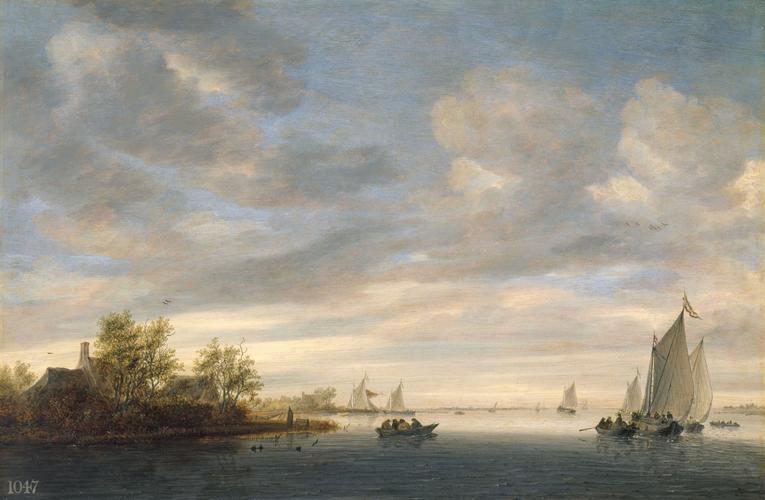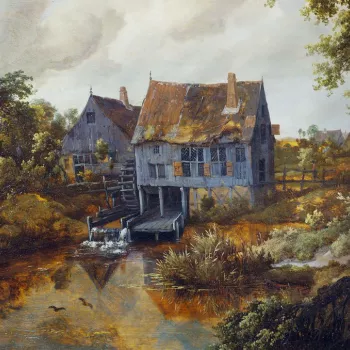A River Landscape with Sailing Boats Signed and dated 1651
Oil on panel | 44.6 x 68.3 cm (support, canvas/panel/stretcher external) | RCIN 405517
-
Salomon van Ruysdael (1600/3-70) specialised in river views, but also painted landscapes, seascapes and some still-lifes. Despite the frequent repetition of identifiable motifs in his paintings, they are not repetitive or stylised. Van Ruysdael, along with fellow artists Pieter de Molijn and Jan van Goyen, sought to experiment with the effects of tone in paintings, where mood is evoked not through action, but through the subtle blending of colour and texture to construct an evocative scene.
This painting is typical of the works at the height of van Ruysdael’s career. It captures a moment at dawn on a broad stretch of river which, bearing in mind the size of the sailing boats depicted, is most likely to be an estuary. The sun is rising, and men are being ferried in rowing boats to their vessels. Carel van Mander in his Foundation of the Noble, Free Art of Painting of 1604 had instructed artists how best to approach the demanding task of capturing dawn light. He advised them to be wide awake to observe the beginning of the day, and to keep in mind the imagery and lyrical contours of mythological poetry, likening the clouds and light to the gods and warning artists to ‘… behold how slowly rosy-rimmed/The purple clouds become…’. In this work van Ruysdael seems to have captured the slow unfurling of such purple-tinged dawn light. Despite the ripples on the water and the inclusion of figures beginning their busy day, it is the sky that is the real focus, the roundly curling clouds dominating the composition with a weighty presence. The daringly low horizon line ensures this domination of sky and water and reminds us that the figures within the painting (whether in boats or in the houses sheltered by trees on the left) spend their working lives trying to read the weather upon which their livelihood depends.
As though to continue this theme of the importance of nature, van Ruysdael uses the tools of his practice – the oil paint and the wood of the panel – to articulate further the homogeneity of the scene. The grain of the wood and even its colour serves as the basis for the pattern of waves in the darker-toned water of the foreground, a technique later employed by Willem van de Velde the Younger. This realistic effect is tempered by the poetic reflection of light on water in the middle distance which subtly blends into the sky.
Signed and dated on the rowing boat in centre: 'SvR 1651'Provenance
First recorded in the Royal Collection in 1849
-
Creator(s)
-
Medium and techniques
Oil on panel
Measurements
44.6 x 68.3 cm (support, canvas/panel/stretcher external)
58.2 x 81.0 x 5.5 cm (frame, external)
Other number(s)










